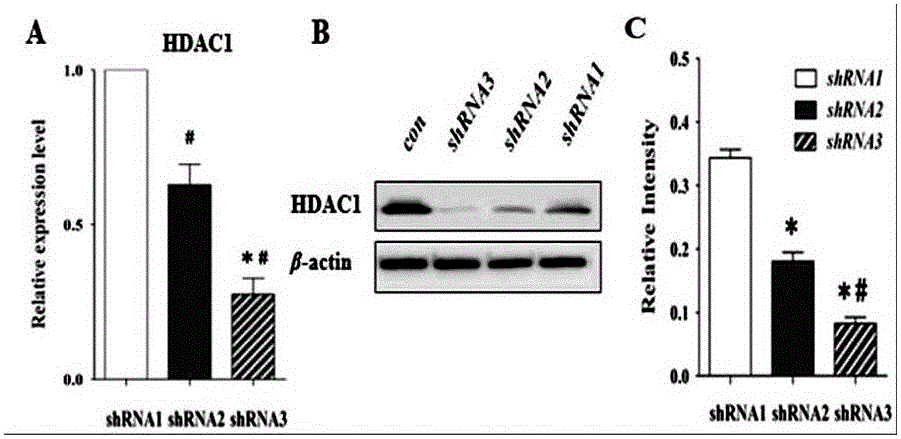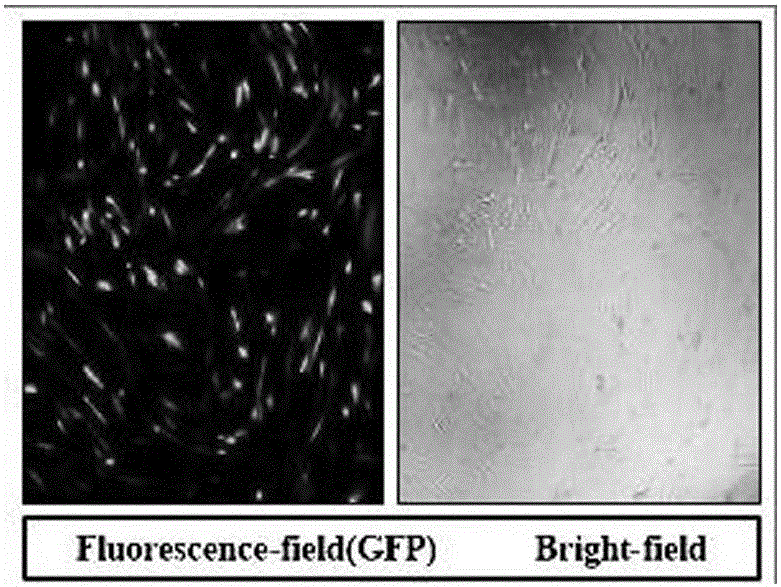Synthesizing method and application for LV-HDAC1shRNA lentivirus of target silence HDAC1 gene
A technology of targeted silencing and synthetic methods, applied in the application field of epigenetic modification drugs, can solve the problems of high experimental cost, low specificity of HDAC inhibitors, high price of HDAC inhibitors, etc., and achieve high transfection efficiency. Effect
- Summary
- Abstract
- Description
- Claims
- Application Information
AI Technical Summary
Problems solved by technology
Method used
Image
Examples
Embodiment 1
[0047] Example 1: Synthesis and screening of LV-HDAC1 with stable targeted silencing ability shRNA lentivirus
[0048] (1) Retrieve the mRNA sequence of human HDAC1 (NM_004964.2) on GenBank, and send 3 specific ones to Gemma Gene shRNA fragments, respectively shRNA1, shRNA2, shRNA3 , the sequence information is shown in Table 1;
[0049]
[0050] (2) Press siRNA : Lipofectamin2000 (1:0.05) transfected HEK293 cells, placed in CO 2 Cultivate in an incubator for 72 hours, extract total RNA from cells; use real-time fluorescent PCR technology (see Table 2 for primers, and see figure 1 -A), Western blot detection screened out the one with the best interference HDAC1 efficiency shRNA Fragment ( figure 1 -B,C, C is the grayscale analysis result of B), namely shRNA3. Note: *: with shRNA1 group compared to P shRNA2 group compared to P <0.05.
[0051]
[0052] (3) put shRNA3 The sense strand and antisense strand were dissolved in annealing buffer, placed in a w...
Embodiment 2
[0065] Example 2: Lentivirus LV-HDAC1 shRNA Infect hUC-MSCs and screen for HDAC1 shRNA - MSC cell line
[0066] The lentivirus LV-HDAC1 prepared in Example 1 shRNA Infect hUC-MSCs, screen HDAC1 that can target silencing of HDAC1 gene, regulate intracellular acetylation level, and proliferate well shRNA - MSC stable strain, the specific steps are as follows:
[0067] (1) Divide hUC-MSCs cells into 3~5×10 4 ml -1 Density seeding in 12 wells of a 96-well plate with a volume of 90 μl, cultured in a cell incubator for 24 hours;
[0068] (2) Preparation of infection reagents:
[0069] Prepare polybrene (M): dilute polybrene with Complete Medium to a final concentration of 50 μg / ml;
[0070] Prepare polybrene (E): dilute polybrene with Eni.s to a final concentration of 50 μg / ml;
[0071] Dilute the virus to three titers using Eni.s: Group A 1×10 8 TU / ml, group B 1×10 7 TU / ml, group C 1×10 6 TU / ml.
[0072] (3) From left to right on the abscissa: Complete Medium, polybr...
Embodiment 3
[0083] Example 3: Compound Induction Medium Neural Differentiation Induces MSC and HDAC1 shRNA - MSC cells, to assess the effect of lentiviruses on the neural differentiation of MSCs
[0084] The present invention uses neural differentiation induction medium to induce MSC and HDAC1 shRNA -MSC cells, qRT-PCR, immunofluorescence to assess lentivirus LV-HDAC1 shRNA For the impact on hUC-MSCs, the specific steps are as follows:
[0085] (1) Adjust MSC and HDAC1 with DMEM-LG medium shRNA -MSC cells at a density of 2 x 10 5 ml -1 , constant temperature culture to 60% confluence, DA differentiation medium pre-induction for 2 days, DB differentiation medium induction for 1 day, DC differentiation medium maintenance induction for 1 day, complete neural differentiation induction, and the characteristics of the induction medium are:
[0086] The DA differentiation medium is composed of 40ml FBS and 10μg bFGF per 1000ml DMEM-LG medium, and the final concentration of bFGF reaches 10 ...
PUM
 Login to View More
Login to View More Abstract
Description
Claims
Application Information
 Login to View More
Login to View More - R&D
- Intellectual Property
- Life Sciences
- Materials
- Tech Scout
- Unparalleled Data Quality
- Higher Quality Content
- 60% Fewer Hallucinations
Browse by: Latest US Patents, China's latest patents, Technical Efficacy Thesaurus, Application Domain, Technology Topic, Popular Technical Reports.
© 2025 PatSnap. All rights reserved.Legal|Privacy policy|Modern Slavery Act Transparency Statement|Sitemap|About US| Contact US: help@patsnap.com



